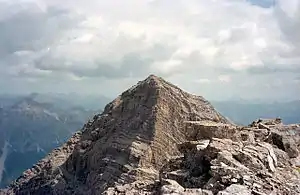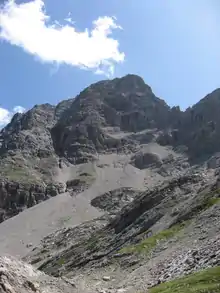Urbeleskarspitze
The Urbeleskarspitze is a 2,632-metre-high mountain peak in the Allgäu Alps. It lies within Austria in the state of Tyrol and is the fifth-highest summit in the Allgäu Alps and the second-highest peak in the Hornbach chain. Its neighbours in the Hornbach chain are the Bretterspitze to the southwest and the Zwölfer Spitze to the northeast.
| Urbeleskarspitze | |
|---|---|
 The Urbeleskarspitze | |
| Highest point | |
| Elevation | 2,632 m (AA) (8,635 ft) |
| Prominence | 375 m ↓ Schönecker Scharte |
| Isolation | 8.9 km → Großer Krottenkopf |
| Coordinates | 47°20′12″N 10°28′06″E |
| Geography | |
| Parent range | Allgäu Alps (Hornbach chain) |
| Geology | |
| Mountain type | Rock summit |
| Type of rock | Main Dolomite (Triassic) |
| Climbing | |
| First ascent | 1869 Hermann von Barth |
| Normal route | Hinterhornbach – Kaufbeurer Haus – Urbeleskarspitze |

Rock and structure
Like most of the high mountains in the Allgäu Alps the Urbeleskarspitze consists of main dolomite. Its summit has a striking bell-shaped appearance and is easily identified from the north and south from nearby and more distant summits.
First ascent
Who first climbed the Urbeleskarspitze cannt be precisely determined. Candidates include unknown locals or a "Dr. Gümbel" in 1854. It was certainly ascended in 1869 by Hermann von Barth.[1]
Bases
The main starting point for ascents is the village of Hinterhornbach in a side valley of the Tyrolean Lechtal. From there it is roughly 2½ hours to the Kaufbeurer Haus, a self-service hut belonging to the DAV. The hut is regularly manned at weekends from Pentecost to early October but is otherwise only open to members of the Alpine Club with a key.
Ascent
There is no simple way leading to the summit of the Urbeleskarspitze. The two usable routes from the Kaufbeurer Haus require sure-footedness, a head for heights and Alpine experience and climbing preparedness.
The only partially marked normal route is graded as UIAA II+ and takes just under 2 hours through steep schrofen terrain over the northwest flank to reach the top.
An alternative climb existed over the north arête. It was a UIAA grade II and ran through broken rock, also taking 2 hours to reach the summit of the Urbeleskarspitze.
References
- Ernst Zettler, Heinz Groth: Alpenvereinsführer - Allgäuer Alpen. 12th full revised edition. Bergverlag Rudolf Rother, Munich, 1985, ISBN 3-7633-1111-4 (p. 385).
Literature/ Maps
- Zettler, Ernst (1979). Allgäuer Alpen : e. Führer für Täler, Hütten u. Berge. München: Bergverlag Rother. ISBN 3763311017.
- Seibert, Dieter (2004). Allgäuer Alpen und Ammergauer Alpen alpin (in German). ISBN 3763311262.
- Alpine Club map 2/2 Allgäuer-Lechtaler Alpen – Ost 1:25,000 map series, 7th edition, 2002
- Thaddäus, Steiner (2007). Allgäuer Bergnamen (in German) (3rd ed.). Fink Kunstverlag Josef. ISBN 9783898703895.
